Beatles Solo Career
The break-up of the Beatles, one of the most popular and influential musical groups in history, has become almost as much of a legend as the band itself or the music they created while together. The Beatles were active from their formation in 1960 to the disintegration of the group in 1970.
The break-up itself was a cumulative process throughout 1968 to 1970, marked by rumors of a split and ambiguous comments by the Beatles themselves regarding the future of the group. Although in September 1969 John Lennon privately informed the other Beatles that he was leaving the group, there was no public acknowledgment of the break-up until Paul McCartney announced on 10 April 1970 he was leaving the Beatles.
There were sporadic collaborative recording efforts among the band members (Ringo Starr’s 1973 album Ringo was the only time that the four – albeit on separate tracks – appeared on the same album post-break-up), although all four Beatles never simultaneously collaborated as a recording or performing group again; Starr’s 1976 album Ringo’s Rotogravure is the last post-break-up album on which all four Beatles contribute and are credited: besides Starr’s drumming and songwriting contributions, Lennon, McCartney and George Harrison all composed one track apiece. After Lennon’s death in 1980, McCartney and Starr appeared on Harrison’s single “All Those Years Ago”, and the trio reunited for the Anthology project in 1994, using two unfinished Lennon demos – “Free as a Bird” and “Real Love” – for what would be new songs to be recorded and released as the Beatles.
There were numerous causes for the Beatles’ break-up. It was not a single event but a long transition, including the cessation of touring in 1966, and the death of their manager, Brian Epstein, in 1967, meaning the Beatles were personally involved in financial and legal conflicts. Conflict arose from differences in artistic vision. Both Harrison and Starr temporarily left the group at various points during 1968–69 and all four band members had begun working on solo projects by 1970 as they all realized the likelihood the band would not regroup. Ultimately, animosity made it impossible for the group to continue working together in the years following.
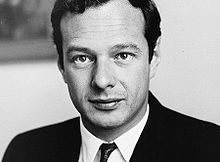 Arguably the most influential person in launching and promoting the band’s worldwide popularity, Brian Epstein also managed to hold the group together, as his management style was to let the group pursue their musical notions and projects while often mediating when there was a conflict. However, this role began to diminish after the band stopped touring in 1966, although he still exercised a strong influence, settling disputes among members and, most importantly, handling the group’s finances. When he died of a medical drug overdose in August 1967, there was a void left in the band. John Lennon had the closest personal relationship with Epstein and was the most affected by his death.
Arguably the most influential person in launching and promoting the band’s worldwide popularity, Brian Epstein also managed to hold the group together, as his management style was to let the group pursue their musical notions and projects while often mediating when there was a conflict. However, this role began to diminish after the band stopped touring in 1966, although he still exercised a strong influence, settling disputes among members and, most importantly, handling the group’s finances. When he died of a medical drug overdose in August 1967, there was a void left in the band. John Lennon had the closest personal relationship with Epstein and was the most affected by his death.
Paul McCartney likely sensed the precarious situation and sought to initiate projects for the group. Lennon, George Harrison and Ringo Starr progressively became perturbed by his growing domination in musical as well as other group ventures. Lennon later reflected that McCartney’s efforts were important for the survival of the band, but he still believed that McCartney’s desire to help came from McCartney’s own misgivings about pursuing a solo career.
The foundation of Apple Corps was initiated under the oversight of Epstein as a tax shelter endeavor. His unexpected death left the future of Apple Corps in doubt. The lack of Epstein’s supervision and the Beatles’ inexperience as businessmen led to an unexpectedly chaotic venture that only added to stress when the band returned to the studio to produce their 1968 double album The Beatles, also known as the White Album. Epstein’s role as band manager would never be replaced, and ultimately the lack of strong managerial leadership would be a major cause of the break-up.
 Another factor behind the Beatles’ eventual split was Harrison’s growth as a composer during the second half of their career.] In the early years, Lennon and McCartney were the band’s primary songwriters and vocalists, as Harrison and Starr took more supporting roles. Lennon and McCartney would often compose one song per album for Starr to sing, while Harrison would either cover an old standard or record one of his own compositions. From 1965 onwards, Harrison’s compositions started to mature and become more appealing in their quality. Gradually, the other band members acknowledged his potential as a songwriter.
Another factor behind the Beatles’ eventual split was Harrison’s growth as a composer during the second half of their career.] In the early years, Lennon and McCartney were the band’s primary songwriters and vocalists, as Harrison and Starr took more supporting roles. Lennon and McCartney would often compose one song per album for Starr to sing, while Harrison would either cover an old standard or record one of his own compositions. From 1965 onwards, Harrison’s compositions started to mature and become more appealing in their quality. Gradually, the other band members acknowledged his potential as a songwriter.
Although Harrison emerged as a talented songwriter and producer, he nonetheless continued to have many of his song ideas rejected by Lennon and McCartney, especially from 1968 onwards. While this was partly indicative of the increased competition for space on album sides, with three songwriters in the band, Harrison’s frustration fostered in him a sense of alienation from the Beatles.
He was the first member of the group to release a solo album, with Wonderwall Music, much of which was recorded in Bombay in January 1968 and featured Indian classical musicians such as Aashish Khan, Shankar Ghosh and Shivkumar Sharma. Speaking to Melody Maker in September 1969, Lennon said: “The trouble is we’ve got too much material. Now that George is writing a lot, we could put out a double album every month.
After the band had stopped touring in August 1966, each of the members, to varying degrees, began to pursue his own musical tastes. When the group convened to record Sgt. Pepper’s Lonely Hearts Club Band in November 1966, there was still a camaraderie and desire to collaborate as musicians.
However, their individual differences were becoming more apparent. To a greater extent than the others, McCartney maintained a deep interest in the pop musical trends and styles emerging both in Britain and the United States, whereas Harrison developed an interest in Indian music, and Lennon’s compositions became more introspective and experimental. Consequently, McCartney began to assume the role of the initiator and leader of the artistic projects of the Beatles.
Each band member began to develop individual artistic agendas, which eventually compromised the enthusiasm among the musicians. Soon, each band member became impatient with the others. This became most evident on the White Album, in which personal artistic preferences began to dominate the recording sessions, which in turn further undermined the band’s unity.
Lennon was in a fragile state of mind after returning from the band’s sojourn in India in early 1968. He was disillusioned and resentful that their Transcendental Meditation guru, Maharishi Mahesh Yogi, had not fulfilled his expectations.
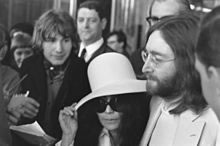 Coupled with renewed drug use and deterioration in his marriage and family life, Lennon’s personal identity and artistic role within the Beatles was a source of discontent. He began to develop an intense interest in the work of Yoko Ono, a Japanese-American conceptual artist whom he had first met at one of her exhibitions in 1966.
Coupled with renewed drug use and deterioration in his marriage and family life, Lennon’s personal identity and artistic role within the Beatles was a source of discontent. He began to develop an intense interest in the work of Yoko Ono, a Japanese-American conceptual artist whom he had first met at one of her exhibitions in 1966.
The pair maintained a platonic relationship until the spring of 1968. In May that year, they spent time together in his home studio while his wife, Cynthia, was away on holiday. They recorded an avant-garde tape that would eventually be released as Unfinished Music No.1: Two Virgins, before consummating their new relationship. From that point on, the two were almost always together, even as Lennon was working with the rest of the band in the studio. This violated a previous tacit agreement between the members not to let wives or girlfriends into the studio.
In addition, as Lennon’s artistic infatuation with Ono grew, he desired that she would be allotted artistic input into the band’s recordings. Frequently, Ono would comment or make suggestions in the recording studio, which only served to increase the friction between her and Lennon’s bandmates.
Ono’s intrusive presence was a source of rancor to Harrison, in particular, after his and Lennon’s shared experimentation with LSD and Indian spirituality – two experiences that McCartney had approached with a level of caution – had united the pair since 1965.
In May 1968, the band met at Harrison’s home in Esher to record demos of some of the songs that would be released in November as The Beatles. Contemporaneous reviews and retrospective commentary by the Beatles acknowledged that the double album reflected the development of autonomous composers, musicians and artists. Rolling Stone described it as “four solo albums in one roof”.
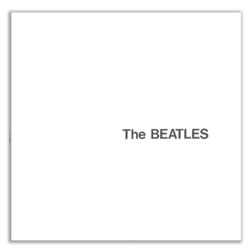 Lennon and McCartney’s artistic venues for the Beatles became more disparate, with McCartney disapproving of Lennon and Ono’s experimental sound collage “Revolution 9”, and Lennon contemptuous of light-hearted McCartney songs such as “Martha My Dear” and “Honey Pie”.
Lennon and McCartney’s artistic venues for the Beatles became more disparate, with McCartney disapproving of Lennon and Ono’s experimental sound collage “Revolution 9”, and Lennon contemptuous of light-hearted McCartney songs such as “Martha My Dear” and “Honey Pie”.
Harrison continued to develop as a songwriter, yet he received little support from within the band during the sessions. Feeling resentment from Lennon and McCartney for his role in leading the Beatles to the Maharishi, Harrison’s composition “Not Guilty” reflected his state of mind after their return from India.
Starr began to develop and pursue acting opportunities during this period, yet as a drummer, he was becoming increasingly dissatisfied with the standard of his playing; according to author Mark Hertsgaard, this was “a feeling that [McCartney] in particular had done much to encourage”. Distressed also by the sour and tense atmosphere that was characteristic of the recording sessions, Starr felt so isolated that he left the band for several weeks and holidayed with his family in Sardinia. He returned in early September to find his drum kit decorated with flowers, which were a gift from Harrison.
The strain of recording the White Album also took its toll on EMI recording engineer Geoff Emerick. Like Starr, he left during the sessions, which commenced in June and concluded in October. These were the first signs of the group’s emerging disunity and antipathy.
Upon completion and release of The Beatles, the band no longer gave collective interviews or recorded appearances. The public relations were carried out individually. Other evidence of the group’s collective alienation came with the release of their 1968 Christmas fan club recording. The contributions were entirely individual and Lennon made disparaging remarks about his bandmates’ apparent disdain for Ono.
By the end of 1968, the Beatles’ status as a group entity was in limbo. McCartney suggested a group project involving rehearsing, recording and performing the songs in a live concert. The project soon adopted a working title of Get Back but would eventually see official release as the Let It Be album and film in 1970. Although the sessions for their double album had involved a degree of ensemble playing, the band were ill-prepared to settle comfortably back into this mode; in particular, Lennon had descended into heroin addiction, leaving him variously incommunicative or highly critical of the venture.
On 10 January 1969, eight days after filmed rehearsals commenced at Twickenham Film Studios, Harrison’s frustration and resentment peaked and he informed his bandmates that he was leaving. Having enjoyed rewarding collaborations outside the Beatles during much of 1968, particularly with Eric Clapton, Bob Dylan and the Band, the combined patronizing by McCartney and estrangement from Lennon had taken its toll. The band was therefore on the verge of potential collapse and at an impasse. In 2003, Rolling Stone magazine cited a recording that exists from the Twickenham sessions the day after Harrison’s departure in which Lennon suggests inviting Clapton to take over lead guitar duties.
Ultimately, complicated negotiations brought Harrison back into the group’s activities. At Harrison’s insistence, McCartney’s plans for a full concert were abandoned and the project was relocated to the band’s Apple Studio in Savile Row, with the focus now on merely completing a new album of some of the songs rehearsed at Twickenham. The Beatles gave their last public performance on the rooftop of Apple’s headquarters on 30 January 1969, as a substitute for an audience-based concert.
Business quagmire: Allen Klein, Lee and John Eastman, and ATV-Northern Songs
Apple Corps during this period was plagued by business problems. On 26 January 1969 Lennon and Ono met with Allen Klein regarding managerial advice. Lennon requested that Klein represent his business interests in the band. McCartney’s growing relationship with Linda Eastman, whom he married on 12 March, opened the opportunity for lawyers Lee and John Eastman, Linda’s father and brother, respectively, to become involved in advising the band’s financial and legal decision-making.
After a series of rancorous meetings between Klein, the Eastmans, and the Beatles, in April Klein was appointed as the band’s business manager on an interim basis, with the Eastmans as the Beatles’ attorneys. However, the band members’ quarrels and disharmony over musical matters soon permeated their business discussions.
Dick James, who held substantial rights to Northern Songs (the Lennon–McCartney song catalogue), became increasingly concerned over the band’s dissension and resentment towards him. Without informing the Beatles, he inconspicuously entertained offers to sell his substantial shares in Northern Songs. Klein and the Eastmans were caught off guard and their attempts to reclaim control of the Beatles (via Maclen Music) failed. It soon became evident that the Eastmans and Klein had developed an adversarial relationship given their disparate advice and counsel. Given a choice between Klein, Lennon’s choice of adviser, and the Eastmans,
McCartney’s choice, Harrison and Starr voted for Klein. The Eastmans were dismissed as the Beatles’ attorneys, and on 8 May Lennon, Harrison, and Starr signed a contract with Klein to be the band’s business manager. This further aggravated the underlying mistrust and antipathy experienced within the band. McCartney felt that the four members’ evolution from musicians to businessmen was the central reason for the band’s breakup.
Departures
Soon after the sessions for Abbey Road, Lennon’s heroin use inspired him to record “Cold Turkey” with his and Ono’s conceptual group, the Plastic Ono Band, after the Beatles had rejected the song for release as a single. The formation of the Plastic Ono Band was conceived as an artistic outlet for Lennon and Ono, but the enthusiastic reception afforded their performance at the Toronto Rock and Roll Revival in September 1969 ostensibly crystallized Lennon’s decision to leave the Beatles.During a band meeting at Apple on 20 September, he informed McCartney, Starr and Klein of his decision.
That same month, the band signed a renegotiated recording contract with Capitol Records, guaranteeing them a higher royalty rate. This was the group’s last, transient demonstration of unity, and the sensitivity of the negotiations with Capitol led to Klein and McCartney urging Lennon to keep his announcement private, which Lennon agreed to do.
Having long attempted to maintain cohesiveness within the Beatles, McCartney secluded himself with his new family at his Scottish farm, distraught at Lennon’s departure. After being tracked down by reporters from Life magazine in late October, McCartney publicly acknowledged that “the Beatle thing is over”, although the full meaning of this remark was ignored.
In early January 1970, he, Harrison and Starr briefly reconvened at Abbey Road Studios to record Harrison’s “I Me Mine” and complete work on McCartney’s song “Let It Be”.
Both tracks were needed for the Let It Be album, as the threat of legal action by American film company United Artists led to a decision to finally prepare the Get Back recordings and footage for release. This project was then allowed to languish as before, until producer Phil Spector was invited to revisit the tapes. Although McCartney has claimed that he was unaware of Spector’s involvement until receiving an acetate of the Let It Be album in April, Peter Doggett writes of work being delayed for “several weeks” until McCartney returned “a string of messages” requesting his approval for Spector to start working on the tapes.
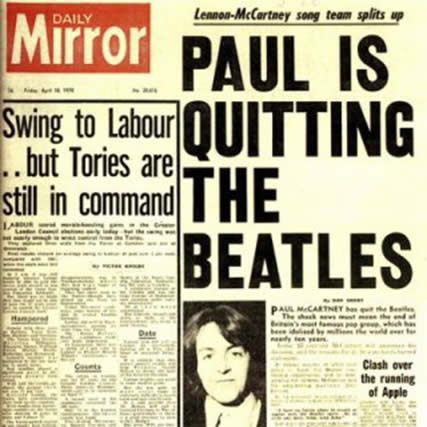
Effectively estranged from his bandmates and deeply depressed,McCartney had begun making a series of home recordings in London during December 1969. Operating under strict secrecy, McCartney privately agreed a release date for this proposed solo album, titled McCartney, with Apple Records executive Neil Aspinall.The release was set for 17 April 1970. Once Lennon, Harrison and Starr became aware of it, however, the date was immediately deemed as problematic, due to the existing items on the Apple release schedule – Let It Be and Starr’s own solo debut, Sentimental Journey.
On 31 March, Starr went to McCartney’s house to tell him personally of the decision to delay the release of McCartney, news to which he reacted badly, dismissing Starr from his home, and refusing to cede the date agreed to with Aspinall. Stunned at his bandmate’s outburst, Starr relayed the situation to Harrison and Lennon, and McCartney’s album was reinstated on the release schedule for 17 April.
The release was set for 17 April 1970. Once Lennon, Harrison and Starr became aware of it, however, the date was immediately deemed as problematic, due to the existing items on the Apple release schedule – Let It Be and Starr’s own solo debut, Sentimental Journey. On 31 March, Starr went to McCartney’s house to tell him personally of the decision to delay the release of McCartney, news to which he reacted badly, dismissing Starr from his home, and refusing to cede the date agreed to with Aspinall. Stunned at his bandmate’s outburst, Starr relayed the situation to Harrison and Lennon, and McCartney’s album was reinstated on the release schedule for 17 April.
McCartney’s bitterness over this episode contributed to him publicly announcing his departure from the band during the second week of April 1970. He has also cited Spector’s treatment of some songs on the Let It Be album, particularly “The Long and Winding Road”, as another factor. The chronological relevance of the latter claim is disputed by Starr, however, who stated that, when acetates of the album were sent out for each of the Beatles’ approval, on 2 April: “We all said yes. Even at the beginning Paul said yes. I spoke to him on the phone, and said, ‘Did you like it?’ and he said, ‘Yeah, it’s OK.’ He didn’t put it down.”
McCartney’s announcement came via a press release distributed to select UK journalists on 9 April, with advance copies of McCartney. The press release took the form of a Q&A in which McCartney discussed his album and, with Lennon’s exit still being withheld from the public (for business reasons), matters pertaining to the Beatles’ immediate future. While McCartney did not state that the group had broken up, he talked of his “break with the Beatles” and having no plans to work with the band in the future; he also emphasised his distance from Klein’s management and ruled out the likelihood of ever writing songs with Lennon again.
Although McCartney has said that Apple’s press officer, Derek Taylor, submitted the questions, Taylor later insisted that those concerning the Beatles were added by McCartney. On 10 April, having been among the recipients of the Q&A, Don Short of The Daily Mirror reported on McCartney’s departure from the Beatles, after which newspapers around the world interpreted McCartney’s remarks as an announcement that the band had broken up.
John Lennon was an English singer and songwriter who co-founded the Beatles, the most commercially successful band in the history of popular music. He and fellow member Paul McCartney formed a celebrated songwriting partnership.
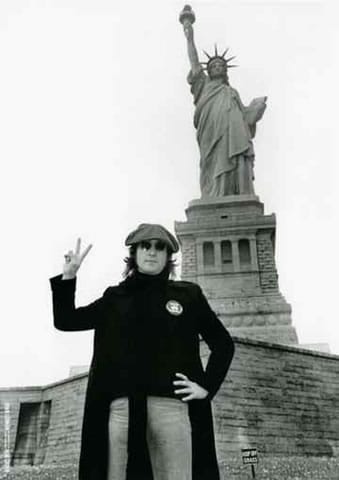
Born and raised in Liverpool, Lennon became involved in the skiffle craze as a teenager; his first band, the Quarrymen, evolved into the Beatles in 1960. When the group disbanded in 1970, Lennon embarked on a sporadic solo career that produced albums including John Lennon/Plastic Ono Band and Imagine, and songs such as “Give Peace a Chance”, “Working Class Hero”, and “Imagine”. After his marriage to Yoko Ono in 1969, he changed his name to John Ono Lennon. Lennon disengaged himself from the music business in 1975 to raise his infant son Sean, but re-emerged with Ono in 1980 with the new album Double Fantasy. He was murdered three weeks after its release.
Lennon revealed a rebellious nature and acerbic wit in his music, writing, drawings, on film and in interviews. Controversial through his political and peace activism, he moved to Manhattan in 1971, where his criticism of the Vietnam War resulted in a lengthy attempt by Richard Nixon’s administration to deport him, while some of his songs were adopted as anthems by the anti-war movement and the larger counterculture.
1970, Lennon and Ono went through primal therapy with Arthur Janov in Los Angeles, California. Designed to release emotional pain from early childhood, the therapy entailed two half-days a week with Janov for four months; he had wanted to treat the couple for longer, but they felt no need to continue and returned to London.
Lennon’s emotional debut solo album, John Lennon/Plastic Ono Band (1970), was received with high praise. Lennon and Ono moved to New York in August 1971, and released “Happy Xmas (War Is Over) in December”.
The new year saw the Nixon administration take what it called a “strategic counter-measure” against Lennon’s anti-war and anti-Nixon propaganda, embarking on what would be a four-year attempt to deport him. In 1972, Lennon and Ono attended a post-election wake held in the New York home of activist Jerry Rubin after McGovern lost to Nixon. While Lennon was recording Mind Games (1973), he and Ono decided to separate. The ensuing 18-month period apart, which he later called his “lost weekend”, was spent in Los Angeles and New York in the company of May Pang. Mind Games, credited to the “Plastic U.F.Ono Band”, was released in November 1973. Lennon also contributed “I’m the Greatest” to Starr’s album Ringo (1973), released the same month (an alternate take, from the same 1973 Ringo sessions, with Lennon providing a guide vocal, appears on John Lennon Anthology).
The new year saw the Nixon administration take what it called a “strategic counter-measure” against Lennon’s anti-war and anti-Nixon propaganda, embarking on what would be a four-year attempt to deport him. In 1972, Lennon and Ono attended a post-election wake held in the New York home of activist Jerry Rubin after McGovern lost to Nixon. While Lennon was recording Mind Games (1973), he and Ono decided to separate. The ensuing 18-month period apart, which he later called his “lost weekend”, was spent in Los Angeles and New York in the company of May Pang. Mind Games, credited to the “Plastic U.F.Ono Band”, was released in November 1973. Lennon also contributed “I’m the Greatest” to Starr’s album Ringo (1973), released the same month (an alternate take, from the same 1973 Ringo sessions, with Lennon providing a guide vocal, appears on John Lennon Anthology).
In early 1974, Lennon was drinking heavily and his alcohol-fuelled antics with Harry Nilsson made headlines. Two widely publicized incidents occurred at The Troubadour club in March, the first when Lennon placed a menstrual pad on his forehead and scuffled with a waitress, and the second, two weeks later, when Lennon and Nilsson were ejected from the same club after heckling the Smothers Brothers. Lennon decided to produce Nilsson’s album Pussy Cats, and Pang rented a Los Angeles beach house for all the musicians. After a month of further debauchery, the recording sessions were in chaos, and Lennon returned to New York with Pang to finish work on the album. In April, Lennon had produced the Mick Jagger song “Too Many Cooks (Spoil the Soup)” which was, for contractual reasons, to remain unreleased for more than 30 years. Pang supplied the recording for its eventual inclusion on The Very Best of Mick Jagger (2007).
Settled back in New York, Lennon recorded the album Walls and Bridges. Released in October 1974, it included “Whatever Gets You thru the Night”, which featured Elton John on backing vocals and piano, and became Lennon’s only single as a solo artist to top the US Billboard Hot 100 chart during his lifetime. A second single from the album, “#9 Dream”, followed before the end of the year. Starr’s Goodnight Vienna (1974) again saw assistance from Lennon, who wrote the title track and played piano. On 28 November, Lennon made a surprise guest appearance at Elton John’s Thanksgiving concert at Madison Square Garden, in
On 28 November, Lennon made a surprise guest appearance at Elton John’s Thanksgiving concert at Madison Square Garden, in fulfillment of his promise to join the singer in a live show if “Whatever Gets You thru the Night”—a song whose commercial potential Lennon had doubted—reached number one. Lennon performed the song along with “Lucy in the Sky with Diamonds” and “I Saw Her Standing There”, which he introduced as “a song by an old estranged fiancée of mine called Paul”.
Lennon co-wrote “Fame”, David Bowie’s first US number one, and provided guitar and backing vocals for the January 1975 recording. The same month, Elton John topped the charts with his cover of “Lucy in the Sky with Diamonds”, featuring Lennon on guitar and back-up vocals (Lennon is credited on the single under the moniker of “Dr. Winston O’Boogie”). He and Ono were reunited shortly afterwards. Lennon released Rock ‘n’ Roll (1975), an album of cover songs, in February. “Stand by Me”, taken from the album and a US and UK hit, became his last single for five years.
He made what would be his final stage appearance in the ATV special A Salute to Lew Grade, recorded on 18 April and televised in June. Playing acoustic guitar and backed by an eight-piece band, Lennon performed two songs from Rock ‘n’ Roll (“Stand by Me”, which was not broadcast, and “Slippin’ and Slidin'”) followed by “Imagine”. The band, known as Etc., wore masks behind their heads, a dig by Lennon who thought Grade was two-faced.
Lennon’s second son Sean was born on 9 October 1975, and he took on the role of househusband, beginning what would be a five-year hiatus from the music industry during which he gave all his attention to his family. Within the month, he fulfilled his contractual obligation to EMI/Capitol for one more album by releasing Shaved Fish, a compilation album of previously recorded tracks.
He devoted himself to Sean, rising at 6 am daily to plan and prepare his meals and to spend time with him. He wrote “Cookin’ (In the Kitchen of Love)” for Starr’s Ringo’s Rotogravure (1976), performing on the track in June in what would be his last recording session until 1980. He formally announced his break from music in Tokyo in 1977, saying, “we have basically decided, without any great decision, to be with our baby as much as we can until we feel we can take time off to indulge ourselves in creating things outside of the family.” During his career
During his career break he created several series of drawings, and drafted a book containing a mix of autobiographical material and what he termed “mad stuff”, all of which would be published posthumously.
He formally announced his break from music in Tokyo in 1977, saying, “we have basically decided, without any great decision, to be with our baby as much as we can until we feel we can take time off to indulge ourselves in creating things outside of the family. During his career break he created several series of drawings, and drafted a book containing a mix of autobiographical material and what he termed “mad stuff”, all of which would be published posthumously.
Lennon emerged from his pause in music recording in October 1980 with the single “(Just Like) Starting Over”, followed the next month by the album Double Fantasy, which contained songs written during a journey to Bermuda on a 43-foot sailing boat the previous June, that reflected his fulfilment in his new-found stable family life. Sufficient additional material was recorded for a planned follow-up album Milk and Honey (released posthumously in 1984). Released jointly by Lennon and Ono, Double Fantasy was not well received, drawing comments such as Melody Maker’s “indulgent sterility … a godawful yawn”
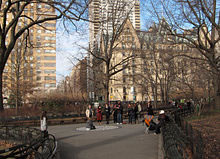 At around 10:50 p.m. (EST) on 8 December 1980, as Lennon and Ono returned to their New York apartment in the Dakota, Mark David Chapman shot Lennon in the back four times in the archway of the building. Lennon was taken to the emergency room of nearby Roosevelt Hospital and was pronounced dead on arrival at 11:00 p.m. (EST).
At around 10:50 p.m. (EST) on 8 December 1980, as Lennon and Ono returned to their New York apartment in the Dakota, Mark David Chapman shot Lennon in the back four times in the archway of the building. Lennon was taken to the emergency room of nearby Roosevelt Hospital and was pronounced dead on arrival at 11:00 p.m. (EST).
Earlier that evening, Lennon had autographed a copy of Double Fantasy for Chapman.
Ono issued a statement the next day, saying “There is no funeral for John”, ending it with the words, “John loved and prayed for the human race. Please do the same for him.”
His body was cremated at Ferncliff Cemetery in Hartsdale, New York. Ono scattered his ashes in New York’s Central Park, where the Strawberry Fields memorial was later created. Chapman pleaded guilty to second-degree murder and was sentenced to 20-years-to-life. In 2016, he was denied parole for a ninth time.
Paul McCartney is an English singer-songwriter, multi-instrumentalist, and composer. With John Lennon, George Harrison, and Ringo Starr, he gained worldwide fame with the rock band the Beatles, largely considered the most popular and influential group in the history of pop music. His songwriting partnership with Lennon is the most celebrated of the post-war era. After the band’s break-up, he pursued a solo career and formed the band Wings with his first wife, Linda, and Denny Laine.
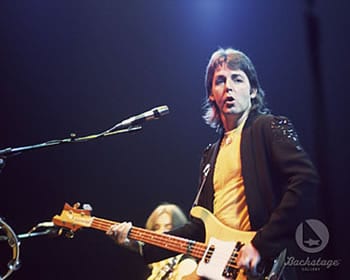 McCartney has released an extensive catalog of songs as a solo artist and has composed classical and electronic music. He has taken part in projects to promote international charities related to such subjects as animal rights, seal hunting, land mines, vegetarianism, poverty, and music education. He has married three times and is the father of five children.
McCartney has released an extensive catalog of songs as a solo artist and has composed classical and electronic music. He has taken part in projects to promote international charities related to such subjects as animal rights, seal hunting, land mines, vegetarianism, poverty, and music education. He has married three times and is the father of five children.
After the Beatles’ break-up in 1970, McCartney continued his musical career with his first solo release, McCartney, a US number-one album. Apart from some vocal contributions from Linda, McCartney is a one-man album, with Paul providing compositions, instrumentation and vocals.
In 1971, he collaborated with Linda and drummer Denny Seiwell on a second album, Ram. A UK number one and a US top five, Ram included the co-written US number-one hit single “Uncle Albert/Admiral Halsey”. Later that year, ex-Moody Blues guitarist Denny Laine joined the McCartneys and Seiwell to form the band Wings. McCartney had this to say on the group’s formation: “Wings were always a difficult idea … any group having to follow [the Beatles’] success would have a hard job … I found myself in that very position. However, it was a choice between going on or finishing, and I loved music too much to think of stopping.” In September 1971, the McCartneys’ daughter Stella was born, named in honor of Linda’s grandmothers, both of whom were named Stella.
Following the addition of guitarist Henry McCullough, Wings’ first concert tour began in 1972 with a debut performance in front of an audience of seven hundred at the University of Nottingham. Ten more gigs followed as they traveled across the UK in a van during an unannounced tour of universities, during which the band stayed in modest accommodation and received pay in coinage collected from students, while avoiding Beatles songs during their performances.
McCartney later said, “The main thing I didn’t want was to come on stage, faced with the whole torment of five rows of press people with little pads, all looking at me and saying, ‘Oh well, he is not as good as he was.’ So we decided to go out on that university tour which made me less nervous … by the end of that tour I felt ready for something else, so we went into Europe.” During the seven-week, 25-show Wings Over Europe Tour, the band played almost solely Wings and McCartney solo material: the Little Richard cover “Long Tall Sally” was the only song that had previously been recorded by the Beatles. McCartney wanted the tour to avoid large venues; most of the small halls they played had capacities of fewer than 3,000 people.
In March 1973, Wings achieved their first US number-one single, “My Love”, included on their second LP, Red Rose Speedway, a US number one and UK top five. Paul’s collaboration with Linda and former Beatles producer Martin resulted in the song “Live and Let Die”, which was the theme song for the James Bond film of the same name. Nominated for an Academy Award, the song reached number two in the US and number nine in the UK. It also earned Martin a Grammy for his orchestral arrangement. Music professor and author Vincent Benitez described the track as “symphonic rock at its best”.
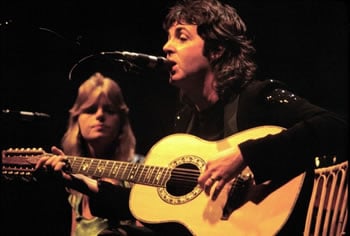 After the departure of McCullough and Seiwell in 1973, the McCartneys and Laine recorded Band on the Run. The album was the first of seven platinum Wings LPs. It was a US and UK number one, the band’s first to top the charts in both countries and the first ever to reach Billboard magazine’s charts on three separate occasions. One of the best-selling releases of the decade, it remained on the UK charts for 124 weeks. Rolling Stone named it Album of the Year for 1974, and in 1975 it won Grammy Awards for Best Contemporary/Pop Vocal and Best Engineered Album. In 1974, Wings achieved a second US number-one single with the title track. The album also included the top-ten hits “Jet” and “Helen Wheels”, and earned the 413th spot on Rolling Stone’s list of the 500 Greatest Albums of All Time.
After the departure of McCullough and Seiwell in 1973, the McCartneys and Laine recorded Band on the Run. The album was the first of seven platinum Wings LPs. It was a US and UK number one, the band’s first to top the charts in both countries and the first ever to reach Billboard magazine’s charts on three separate occasions. One of the best-selling releases of the decade, it remained on the UK charts for 124 weeks. Rolling Stone named it Album of the Year for 1974, and in 1975 it won Grammy Awards for Best Contemporary/Pop Vocal and Best Engineered Album. In 1974, Wings achieved a second US number-one single with the title track. The album also included the top-ten hits “Jet” and “Helen Wheels”, and earned the 413th spot on Rolling Stone’s list of the 500 Greatest Albums of All Time.
Wings followed Band on the Run with the chart-topping albums Venus and Mars (1975) and Wings at the Speed of Sound (1976). In 1975, they began the fourteen-month Wings Over the World Tour, which included stops in the UK, Australia, Europe and the US. The tour marked the first time McCartney performed Beatles songs live with Wings, with five in the two-hour set list: “I’ve Just Seen a Face”, “Yesterday”, “Blackbird”, “Lady Madonna” and “The Long and Winding Road”. Following the second European leg of the tour and extensive rehearsals in London, the group undertook an ambitious US arena tour that yielded the US number-one live triple LP Wings over America.
In September 1977, the McCartneys had a third child, a son they named James. In November, the Wings song “Mull of Kintyre”, co-written with Laine, was quickly becoming one of the best-selling singles in UK chart history. The most successful single of McCartney’s solo career, it achieved double the sales of the previous record holder, “She Loves You”, and went on to sell 2.5 million copies and hold the UK sales record until the 1984 charity single, “Do They Know It’s Christmas?”
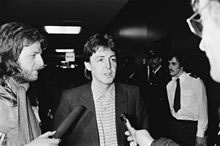 London Town (1978) spawned a US number-one single (“With a Little Luck”), and was Wings’ best-selling LP since Band on the Run, making the top five in both the US and the UK. Critical reception was unfavorable, and McCartney expressed disappointment with the album. Back to the Egg (1979) featured McCartney’s collaboration with a rock supergroup dubbed “the Rockestra”. Credited to Wings, the band included Pete Townshend, David Gilmour, Gary Brooker, John Paul Jones and John Bonham. Though certified platinum, critics panned the album.
London Town (1978) spawned a US number-one single (“With a Little Luck”), and was Wings’ best-selling LP since Band on the Run, making the top five in both the US and the UK. Critical reception was unfavorable, and McCartney expressed disappointment with the album. Back to the Egg (1979) featured McCartney’s collaboration with a rock supergroup dubbed “the Rockestra”. Credited to Wings, the band included Pete Townshend, David Gilmour, Gary Brooker, John Paul Jones and John Bonham. Though certified platinum, critics panned the album.
Wings completed their final concert tour in 1979, with twenty shows in the UK that included the live debut of the Beatles songs “Got to Get You into My Life”, “The Fool on the Hill” and “Let it Be”.
In 1980, McCartney released his second solo LP, the self-produced McCartney II, which peaked at number one in the UK and number three in the US. As with his first album, he composed and performed it alone. The album contained the song “Coming Up”, the live version of which, recorded in Glasgow, Scotland, in 1979 by Wings, became the group’s last number-one hit. By 1981, McCartney felt he had accomplished all he could creatively with Wings and decided he needed a change. The group disbanded in April 1981 following disagreements over royalties and salaries.
1982–90
In 1982 McCartney collaborated with Stevie Wonder on the Martin-produced number-one hit “Ebony and Ivory”, included on McCartney’s Tug of War LP, and with Michael Jackson on “The Girl Is Mine” from Thriller.”Ebony and Ivory” was McCartney’s record 28th single to hit number one on the Billboard 100. The following year, he and Jackson worked on “Say Say Say”, McCartney’s most recent US number one as of 2014. McCartney earned his latest UK number one as of 2014 with the title track of his LP release that year, “Pipes of Peace”.
In 1984, McCartney starred in the musical Give My Regards to Broad Street, a feature film he also wrote and produced which included Starr in an acting role. Disparaged by critics, Variety described the film as “characterless, bloodless, and pointless”. Roger Ebert awarded it a single star and wrote, “you can safely skip the movie and proceed directly to the soundtrack”. The album fared much better, reaching number one in the UK and producing the US top-ten hit single “No More Lonely Nights”, featuring David Gilmour on lead guitar.
In 1985, Warner Brothers commissioned McCartney to write a song for the comedic feature film Spies Like Us. He composed and recorded the track in four days, with Phil Ramone co-producing. McCartney participated in Live Aid, performing “Let it Be”, but technical difficulties rendered his vocals and piano barely audible for the first two verses, punctuated by squeals of feedback. Equipment technicians resolved the problems and David Bowie, Alison Moyet, Pete Townshend and Bob Geldof joined McCartney on stage, receiving an enthusiastic crowd reaction.
McCartney collaborated with Eric Stewart on Press to Play (1986), with Stewart co-writing more than half the songs on the LP. In 1988, McCartney released Choba B CCCP, released only in the Soviet Union, which contained eighteen covers; recorded over the course of two days.
In 1989, he joined forces with fellow Merseysiders Gerry Marsden and Holly Johnson to record an updated version of “Ferry Cross the Mersey”, for the Hillsborough disaster appeal fund. That same year, he released Flowers in the Dirt; a collaborative effort with Elvis Costello that included musical contributions from Gilmour and Nicky Hopkins.
McCartney then formed a band consisting of himself and Linda, with Hamish Stuart and Robbie McIntosh on guitars, Paul “Wix” Wickens on keyboards and Chris Whitten on drums. In September 1989, they launched the Paul McCartney World Tour, his first in over a decade. The following year, he released the triple album, Tripping the Live Fantastic, which contained select performances from the tour.
In 1990, the US publication Amusement Business presented McCartney with an award for the highest grossing show of the year; his two performances at Berkeley earned over $3.5 million. He performed for the largest paying stadium audience in history on 21 April 1990, when 184,000 people attended his concert at Maracanã Stadium in Rio de Janeiro, Brazil.
1991–2000
McCartney ventured into orchestral music in 1991, when the Royal Liverpool Philharmonic Society commissioned a musical piece by him to celebrate its sesquicentennial. He collaborated with composer Carl Davis, producing Liverpool Oratorio.
The performance featured opera singers Kiri Te Kanawa, Sally Burgess, Jerry Hadley and Willard White, with the Royal Liverpool Philharmonic Orchestra and the choir of Liverpool Cathedral. Reviews were negative. The Guardian was especially critical, describing the music as “afraid of anything approaching a fast tempo”, and adding that the piece has “little awareness of the need for recurrent ideas that will bind the work into a whole”.
The paper published a letter McCartney submitted in response in which he noted several of the work’s faster tempos and added, “happily, history shows that many good pieces of music were not liked by the critics of the time so I am content to … let people judge for themselves the merits of the work.”
The New York Times was slightly more generous, stating, “There are moments of beauty and pleasure in this dramatic miscellany … the music’s innocent sincerity makes it difficult to be put off by its ambitions”. Performed around the world after its London premiere, the Liverpool Oratorio reached number one on the UK classical chart, Music Week.
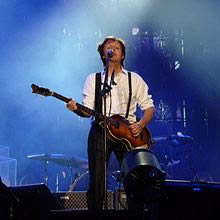 In 1991, McCartney performed a selection of acoustic-only songs on MTV Unplugged and released a live album of the performance titled Unplugged (The Official Bootleg). During the 1990s, McCartney collaborated twice with Youth of Killing Joke as the musical duo “the Fireman”. The two released their first electronica album together, Strawberries Oceans Ships Forest, in 1993.
In 1991, McCartney performed a selection of acoustic-only songs on MTV Unplugged and released a live album of the performance titled Unplugged (The Official Bootleg). During the 1990s, McCartney collaborated twice with Youth of Killing Joke as the musical duo “the Fireman”. The two released their first electronica album together, Strawberries Oceans Ships Forest, in 1993.
McCartney released the rock album Off the Ground in 1993. The subsequent New World Tour followed, which led to the release of the Paul Is Live album later that year.
Starting in 1994, McCartney took a four-year break from his solo career to work on Apple’s Beatles Anthology project with Harrison, Starr and Martin. He recorded a radio series called Oobu Joobu in 1995 for the American network Westwood One, which he described as “widescreen radio”. Also in 1995, Prince Charles presented him with an Honorary Fellowship of the Royal College of Music—”kind of amazing for somebody who doesn’t read a note of music”, commented McCartney.
In 1997, McCartney released the rock album Flaming Pie. Starr appeared on drums and backing vocals in “Beautiful Night”. Later that year, he released the classical work Standing Stone, which topped the UK and US classical charts.
In 1998, he released Rushes, the second electronica album by the Fireman. In 1999, McCartney released Run Devil Run. Recorded in one week, and featuring Ian Paice and David Gilmour, it was primarily an album of covers with three McCartney originals. He had been planning such an album for years, having been previously encouraged to do so by Linda, who had died of cancer in April 1998.
He did an unannounced performance at the benefit tribute, “Concert for Linda,” his wife of 29 years who died a year earlier. It was held at the Royal Albert Hall in London on 10 April 1999, and was organised by two of her close friends, Chrissie Hynde and Carla Lane. Also during 1999, he continued his experimentation with orchestral music on Working Classical.
In 2000, he released the electronica album Liverpool Sound Collage with Super Furry Animals and Youth, using the sound collage and musique concrète techniques that had fascinated him in the mid-1960s. He contributed the song “Nova” to a tribute album of classical, choral music called A Garland for Linda (2000), dedicated to his late wife.
2000–10
Having witnessed the 11 September 2001 attacks from the JFK airport tarmac, McCartney was inspired to take a leading role in organizing the Concert for New York City. His studio album release in November that year, Driving Rain, included the song “Freedom”, written in response to the attacks.
The following year, McCartney went out on tour with a band that included guitarists Rusty Anderson and Brian Ray, accompanied by Paul “Wix” Wickens on keyboards and Abe Laboriel, Jr. on drums.
They began the Driving World Tour in April 2002, which included stops in the US, Mexico and Japan. The tour resulted in the double live album Back in the US, released internationally in 2003 as Back in the World. The tour earned a reported $126.2 million, an average of over $2 million per night, and Billboard named it the top tour of the year. The team continued to play together and McCartney played live with Brian Ray, Rusty Anderson, Abe Laboriel Jr. and Wix Wickens longer than he played live with the Beatles.
In July 2002, McCartney married Heather Mills. In November, on the first anniversary of George Harrison’s death, McCartney performed at the Concert for George. He participated in the National Football League’s Super Bowl, performing “Freedom” during the pre-game show for Super Bowl XXXVI in 2002 and headlining the halftime show at Super Bowl XXXIX in 2005.
The English College of Arms honored McCartney in 2002 by granting him a coat of arms. His crest, featuring a Liver bird holding an acoustic guitar in its claw, reflects his background in Liverpool and his musical career. The shield includes four curved emblems which resemble beetles’ backs. The arms’ motto is Ecce Cor Meum, Latin for “Behold My Heart”. In 2003, the McCartneys had a child, Beatrice Milly.
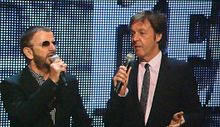 In July 2005, he performed at the Live 8 event in Hyde Park, London, opening the show with “Sgt. Pepper’s Lonely Hearts Club Band” (with U2) and closing it with “Drive My Car” (with George Michael), “Helter Skelter”, and “The Long and Winding Road”. In September, he released the rock album Chaos and Creation in the Backyard, for which he provided most of the instrumentation.
In July 2005, he performed at the Live 8 event in Hyde Park, London, opening the show with “Sgt. Pepper’s Lonely Hearts Club Band” (with U2) and closing it with “Drive My Car” (with George Michael), “Helter Skelter”, and “The Long and Winding Road”. In September, he released the rock album Chaos and Creation in the Backyard, for which he provided most of the instrumentation.
In 2006, McCartney released the classical work Ecce Cor Meum. The rock album Memory Almost Full followed in 2007. In 2008, he released his third Fireman album, Electric Arguments.
Also in 2008, he performed at a concert in Liverpool to celebrate the city’s year as European Capital of Culture. In 2009, after a four-year break, he returned to touring and has since performed over 80 shows.
More than forty-five years after the Beatles first appeared on American television during The Ed Sullivan Show, he returned to the same New York theater to perform on Late Show with David Letterman.
On 9 September 2009, EMI reissued the Beatles catalog following a four-year digital remastering effort, releasing a music video game called The Beatles: Rock Band the same day.
McCartney’s enduring fame has made him a popular choice to open new venues. In 2009, he played three sold-out concerts at the newly built Citi Field—a venue constructed to replace Shea Stadium in Queens, New York. These performances yielded the double live album Good Evening New York City later that year. In 2010, McCartney opened the Consol Energy Center in Pittsburgh, Pennsylvania.
2011–present
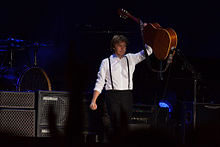 In July 2011, McCartney played two sold-out concerts at the new Yankee Stadium. A New York Times review of the first concert reported that McCartney was “not saying goodbye but touring stadiums and playing marathon concerts.” In September 2011, having been commissioned by the New York City Ballet, McCartney released his first score for dance, a collaboration with Peter Martins called Ocean’s Kingdom.
In July 2011, McCartney played two sold-out concerts at the new Yankee Stadium. A New York Times review of the first concert reported that McCartney was “not saying goodbye but touring stadiums and playing marathon concerts.” In September 2011, having been commissioned by the New York City Ballet, McCartney released his first score for dance, a collaboration with Peter Martins called Ocean’s Kingdom.
Also in 2011, McCartney married Nancy Shevell. He released Kisses on the Bottom, a collection of standards, in February 2012; that same month the National Academy of Recording Arts and Sciences honored him as the MusiCares Person of the Year, two days prior to his performance at the 54th Grammy Awards.
McCartney remains one of the world’s top draws. He played to over 100,000 people total during two performances in Mexico City in May, the shows grossing nearly $6 million. In June 2012, McCartney closed Queen Elizabeth’s Diamond Jubilee Concert held outside Buckingham Palace, performing a set that included “Let It Be” and “Live and Let Die”.
He closed the opening ceremony of the 2012 Summer Olympics in London on 27 July, singing “The End” and “Hey Jude” and inviting the audience to join in on the coda. Having donated his time, he received £1 from the Olympic organizers.
On 12 December, McCartney performed with three former members of Nirvana (Krist Novoselic, Dave Grohl, and Pat Smear) during the closing act of 12-12-12: The Concert for Sandy Relief, seen by approximately two billion people worldwide.
On 28 August 2013, McCartney released the title track of his upcoming studio album New, which came out in October 2013.
A primetime entertainment special celebrating the legacy of seven-time Grammy-winning group the Beatles and their groundbreaking first performance on The Ed Sullivan Show, featuring Paul McCartney and Ringo Starr, was taped 27 January 2014 at the Ed Sullivan Theater with a 9 February 2014 CBS airing. The show, titled The Night That Changed America: A Grammy Salute to The Beatles, featured 22 classic Beatles songs as performed by various artists, including McCartney and Starr.
On 19 May 2014, it was reported that McCartney had been bedridden by an unspecified virus on doctor’s orders, and had to cancel a sold-out concert tour of Japan scheduled to begin later in the week. The tour would have included a stop at the famed Budokan Hall. McCartney also had to push his June US dates to October, as part of his doctor’s order to take it easy to make a full recovery.
However, he resumed the tour with a high-energy three-hour appearance in Albany, New York, on 5 July 2014. On 14 August 2014, McCartney performed the final concert at Candlestick Park in San Francisco, California before its demolition. It was the same venue that the Beatles played their final concert in 1966.
In 2014, McCartney wrote and performed “Hope for the Future,” the ending song for the video game Destiny. In November 2014, a 42-song tribute album titled The Art of McCartney was released, which features a wide range of artists covering McCartney’s solo and Beatles work. Also that year, McCartney collaborated with American recording artist Kanye West on the single “Only One”, released on 31 December.
In January 2015, McCartney collaborated with Kanye West and Barbadian singer Rihanna on the single “FourFiveSeconds”. They released a music video for the song in January and performed it live at the 57th Annual Grammy Awards on 8 February 2015.
McCartney is a featured guest on West’s 2015 single “All Day”, which also features Theophilus London and Allan Kingdom.
On 15 February 2015, McCartney appeared and performed with Paul Simon for the Saturday Night Live 40th Anniversary Special. McCartney and Simon performed the first verse of “I’ve Just Seen a Face” on acoustic guitars, and McCartney later performed “Maybe I’m Amazed”. McCartney shared lead vocals on the Alice Cooper-led Hollywood Vampires supergroup’s cover of his song “Come and Get It” which appears on their debut album, released 11 September 2015.
On 10 June 2016, McCartney released the career-spanning collection Pure McCartney. The set includes songs from throughout McCartney’s solo career and his work with Wings and the Fireman, and is available in three different formats (2-CD, 4-CD, 4-LP and Digital). The 4-CD version includes 67 tracks, the majority of which were top 40 hits.
McCartney will appear in the film Pirates of the Caribbean: Dead Men Tell No Tales, scheduled to be released in 2017.
On 18 January 2017, McCartney filed a suit in United States district court against Sony/ATV Music Publishing seeking to reclaim ownership of his share of the Lennon–McCartney song catalog beginning in 2018. Under US copyright law, for works created before 1978 the author can reclaim copyrights assigned to a publisher after 56 years.
George Harrison was an English guitarist, singer, songwriter, and music and film producer who achieved international fame as the lead guitarist of the Beatles. Often referred to as “the quiet Beatle”, Harrison embraced Hindu mythology and helped broaden the horizons of his fellow Beatles as well as their Western audience by incorporating Indian instrumentation in their music. Although most of the Beatles’ songs were written by John Lennon and Paul McCartney, most Beatles albums from 1965 onwards contained at least two Harrison compositions. His songs for the group included “Taxman”, “Within You Without You”, “While My Guitar Gently Weeps”, “Here Comes the Sun” and “Something”, the last of which became the Beatles’
Although most of the Beatles’ songs were written by John Lennon and Paul McCartney, most Beatles albums from 1965 onwards contained at least two Harrison compositions. His songs for the group included “Taxman”, “Within You Without You”, “While My Guitar Gently Weeps”, “Here Comes the Sun” and “Something”, the last of which became the Beatles’ second-most-covered song.
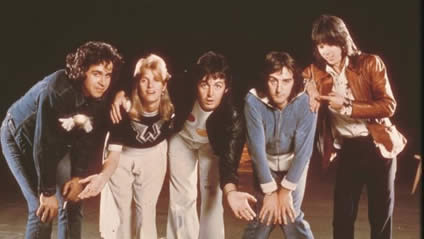
Harrison’s earliest musical influences included George Formby and Django Reinhardt; Carl Perkins, Chet Atkins and Chuck Berry were subsequent influences. By 1965 he had begun to lead the Beatles into folk rock through his interest in the Byrds and Bob Dylan, and towards Indian classical music through his use of the sitar on “Norwegian Wood (This Bird Has Flown)”. Having initiated the band’s embracing of Transcendental Meditation in 1967, he subsequently developed an association with the Hare Krishna movement. After the band’s break-up in 1970, Harrison released the triple album All Things Must Pass, a critically acclaimed work that produced his most successful hit single, “My Sweet Lord”, and introduced his signature sound as a solo artist, the slide guitar. He also organized the 1971 Concert for Bangladesh with Indian musician Ravi Shankar, a precursor for later benefit concerts such as Live Aid. In his role as a music and film producer, Harrison produced acts signed to the Beatles’ Apple record label before founding Dark Horse Records in 1974 and co-founding HandMade Films in 1978.
Harrison released several best-selling singles and albums as a solo performer, and in 1988 co-founded the platinum-selling supergroup the Traveling Wilburys. A prolific recording artist, he was featured as a guest guitarist on tracks by Badfinger, Ronnie Wood and Billy Preston, and collaborated on songs and music with Dylan, Eric Clapton, Ringo Starr and Tom Petty, among others. Rolling Stone magazine ranked him number 11 in their list of the “100 Greatest Guitarists of All Time”. He is a two-time Rock and Roll Hall of Fame inductee – as a member of the Beatles in 1988, and (posthumously) for his solo career in 2004.
Harrison’s first marriage, to model Pattie Boyd in 1966, ended in divorce in 1977. The following year he married Olivia Harrison (née Arias), with whom he had one son, Dhani.
Harrison died in 2001, aged 58, from lung cancer. He was cremated and his ashes were scattered in the Ganges and Yamuna rivers in India, in a private ceremony according to Hindu tradition. He left an estate of almost £100 million.
Early solo work: 1968–69
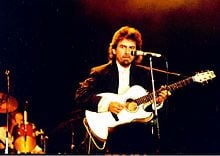 Before the Beatles’ break-up, Harrison had already recorded and released two solo albums: Wonderwall Music and Electronic Sound, both of which contain mainly instrumental compositions. Wonderwall Music, a soundtrack to the 1968 film Wonderwall, blends Indian and Western instrumentation, while Electronic Sound is an experimental album that prominently features a Moog synthesizer. Released in November 1968, Wonderwall Music was the first solo album by a Beatle and the first LP released by Apple Records. Indian musicians Aashish Khan and Shivkumar Sharma performed on the album, which contains the experimental sound collage “Dream Scene”, recorded several months before Lennon’s “Revolution 9”.
Before the Beatles’ break-up, Harrison had already recorded and released two solo albums: Wonderwall Music and Electronic Sound, both of which contain mainly instrumental compositions. Wonderwall Music, a soundtrack to the 1968 film Wonderwall, blends Indian and Western instrumentation, while Electronic Sound is an experimental album that prominently features a Moog synthesizer. Released in November 1968, Wonderwall Music was the first solo album by a Beatle and the first LP released by Apple Records. Indian musicians Aashish Khan and Shivkumar Sharma performed on the album, which contains the experimental sound collage “Dream Scene”, recorded several months before Lennon’s “Revolution 9”.
In December 1969, Harrison participated in a brief tour of Europe with the American group Delaney & Bonnie and Friends. During the tour that included Clapton, Bobby Whitlock, drummer Jim Gordon and band leaders Delaney and Bonnie Bramlett, Harrison began to write “My Sweet Lord”, which became his first single as a solo artist.
Delaney Bramlett inspired Harrison to learn slide guitar, significantly influencing his later music.
All Things Must Pass: 1970
After years of being restricted in his songwriting contributions to the Beatles’ albums, Harrison released All Things Must Pass, a triple album, with two discs of his songs and the third of recordings of Harrison jamming with friends Regarded by many as his best work, the album topped the charts on both sides of the Atlantic The LP produced the number-one hit single “My Sweet Lord” and the top-ten single “What Is Life”.
The album was co-produced by Phil Spector using his “Wall of Sound” approach, and the musicians included Starr, Clapton, Gary Wright, Preston, Klaus Voormann, the whole of Delaney and Bonnie’s Friends band and the Apple group Badfinger. On release, All Things Must Pass was received with critical acclaim; Ben Gerson of Rolling Stone described it as being “of classic Spectorian proportions, Wagnerian, Brucknerian, the music of mountain tops and vast horizons”.
Author and musicologist Ian Inglis considers the lyrics of the album’s title track “a recognition of the impermanence of human existence … a simple and poignant conclusion” to Harrison’s former band.
In 1971 Bright Tunes sued Harrison for copyright infringement over “My Sweet Lord” owing to its similarity to the 1963 Chiffons hit “He’s So Fine”. When the case was heard in the United States district court in 1976, he denied deliberately
On release, All Things Must Pass was received with critical acclaim; Ben Gerson of Rolling Stone described it as being “of classic Spectorian proportions, Wagnerian, Brucknerian, the music of mountain tops and vast horizons”.
Author and musicologist Ian Inglis considers the lyrics of the album’s title track “a recognition of the impermanence of human existence … a simple and poignant conclusion” to Harrison’s former band.
In 1971 Bright Tunes sued Harrison for copyright infringement over “My Sweet Lord” owing to its similarity to the 1963 Chiffons hit “He’s So Fine”. When the case was heard in the United States district court in 1976, he denied deliberately plagiarizing song, but lost the case as the judge ruled that he had done so subconsciously.
In 2000 Apple Records released a thirtieth anniversary edition of the album and Harrison actively participated in its promotion, giving an interview during which he reflected on the work: “It’s just something that was like my continuation from the Beatles, really.
It was me sort of getting out of the Beatles and just going my own way … it was a very happy occasion.” He commented on the production: “Well, in those days it was like the reverb was kind of used a bit more than what I would do now. In fact, I don’t use reverb at all. I can’t stand it … You know, it’s hard to go back to anything thirty years later and expect it to be how you would want it now.”
The Concert for Bangladesh: 1971
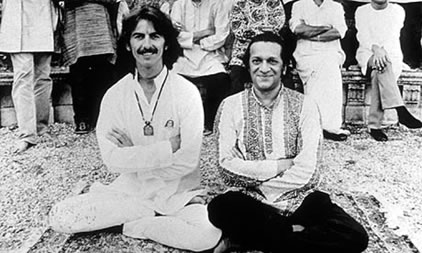 Responding to a request from Ravi Shankar, Harrison organised a charity event, the Concert for Bangladesh, which took place on 1 August 1971, drawing over 40,000 people to two shows in New York’s Madison Square Garden. The goal of the event was to raise money to aid starving refugees during the Bangladesh Liberation War.] Shankar opened the show, which featured popular musicians such as Dylan, Clapton, Leon Russell, Badfinger, Preston and Starr.
Responding to a request from Ravi Shankar, Harrison organised a charity event, the Concert for Bangladesh, which took place on 1 August 1971, drawing over 40,000 people to two shows in New York’s Madison Square Garden. The goal of the event was to raise money to aid starving refugees during the Bangladesh Liberation War.] Shankar opened the show, which featured popular musicians such as Dylan, Clapton, Leon Russell, Badfinger, Preston and Starr.
A triple album, The Concert for Bangladesh, was released by Apple Corps that year, followed by a concert film in 1972. Tax troubles and questionable expenses later tied up many of the proceeds, but Harrison commented: “Mainly the concert was to attract attention to the situation … The money we raised was secondary, and although we had some money problems … they still got plenty … even though it was a drop in the ocean. The main thing was, we spread the word and helped get the war ended.” The event has been described as an innovative precursor for the large-scale charity rock shows that followed, including Live Aid.
Living in the Material World to George Harrison: 1973–79
Harrison would not again release an album that matched the critical and commercial achievements of All Things Must Pass; however, his next solo album, 1973’s Living in the Material World, held the number one spot on the Billboard album chart for five weeks, and the album’s single, “Give Me Love (Give Me Peace on Earth)”, also reached number one in the US.
In the UK, the LP achieved number two, spending 12 weeks on the charts with the single peaking at number 8. The album was lavishly produced and packaged, and its dominant message was Harrison’s Hindu beliefs. In Greene’s opinion it “contained many of the strongest compositions of his career”. Stephen Holden, writing in Rolling Stone, felt the album was “vastly appealing” and “profoundly seductive”, and that it stood “alone as an article of faith, miraculous in its radiance”.
Other reviewers were less enthusiastic, describing the release as awkward, sanctimonious and overly sentimental, a reaction that left Harrison despondent.
In November 1974 Harrison began his 45-date Dark Horse Tour, becoming the first ex-Beatle to tour North America. In addition to performances by Harrison with an ensemble of musicians such as Preston, Tom Scott, Willie Weeks, Andy Newmark and Jim Horn, the tour also included traditional and contemporary Indian music performed by “Ravi Shankar, Family and Friends”.
Despite numerous positive reviews the consensus reaction to the tour was negative, with complaints about the content, structure, and length; the show’s duration of two and a half hours was seen as excessive at the time. Some fans found Shankar’s significant presence a bizarre disappointment, having expected to see only Harrison perform, and many were affronted by what Inglis described as Harrison’s “sermonizing”.
Further, he reworked the lyrics to several Beatles songs, and some of the substitutions were seen as “gratuitously offensive”. His laryngitis-affected vocals also disappointed fans and critics, who began calling the tour “dark hoarse”. Harrison was so deeply bothered by the caustic backlash that he did not tour again until the 1990s. The author Robert Rodriguez commented: “While the Dark Horse tour might be considered a noble failure, there were a number of fans who were tuned-in to what was being attempted. They went away ecstatic, conscious that they had just witnessed something so uplifting that it could never be repeated.” Leng called the tour “groundbreaking” and “revolutionary in its presentation of Indian Music”.
In December Harrison released Dark Horse, an album that earned him the least favourable reviews of his career. Rolling Stone called it “the chronicle of a performer out of his element, working to a deadline, enfeebling his overtaxed talents by a rush to deliver a new ‘LP product’, rehearse a band, and assemble a cross-country tour, all within three weeks”.
The album reached number 4 on the Billboard chart and the single “Dark Horse” reached number 15, but they failed to make an impact in the UK. The music critic Mikal Gilmore described Dark Horse as “one of Harrison’s most fascinating works – a record about change and loss”.
Harrison’s final studio album for EMI and Apple Records was the soul music-inspired Extra Texture (Read All About It) (1975). He considered it the least satisfactory of the three he had recorded since All Things Must Pass. Leng identified “bitterness and dismay” in many of the album’s tracks; his long-time friend Klaus Voormann commented: “He wasn’t up for it … It was a terrible time because I think there was a lot of cocaine going around, and that’s when I got out of the picture … I didn’t like his frame of mind”.
He released two singles from the LP: “You”, which reached the Billboard top 20, and “This Guitar (Can’t Keep from Crying)”, Apple’s final original single release.
Thirty Three & 1/3 (1976), Harrison’s first album release on his own Dark Horse Records label, produced the hit singles “This Song” and “Crackerbox Palace”, both of which reached the top 25 in the US. The surreal humour of “Crackerbox Palace” reflected Harrison’s association with Monty Python’s Eric Idle, who directed a comical music video for the song.
With an emphasis on melody and musicianship, and a more subtle subject matter than the pious message of his earlier works, Thirty Three & 1/3 earned Harrison his most favourable critical notices in the US since All Things Must Pass
In 1979, following his second marriage and the birth of his son Dhani, he released George Harrison. The album and the single “Blow Away” both made the Billboard top 20. The album marked the beginning of Harrison’s gradual retreat from the music business, and the fruition of ideas introduced on All Things Must Pass. In 1978 the death of his father in May and the birth of his son in August had influenced his decision to devote more time to his family than to his career. Leng described the album as “melodic and lush … peaceful … the work of a man who had lived the rock and roll dream twice over and was now embracing domestic as well as spiritual bliss”.
Somewhere in England to Cloud Nine: 1980–87
The murder of Lennon on 8 December 1980 disturbed Harrison and reinforced his decades-long concerns about stalkers. It was also a deep personal loss, although unlike McCartney and Starr, Harrison had had little contact with Lennon in the years before his death.
Following the murder, Harrison commented: “After all we went through together I had and still have great love and respect for John Lennon. I am shocked and stunned.”
Harrison modified the lyrics of a song he had written for Starr to make it a tribute song to Lennon. “All Those Years Ago”, which included vocal contributions from Paul and Linda McCartney, as well as Starr’s original drum part, peaked at number two in the US charts.
The single was included on the album Somewhere in England in 1981. Harrison did not release any new albums for five years after 1982’s Gone Troppo received little notice from critics or the public.
During this period he made several guest appearances, including a 1985 performance at a tribute to Carl Perkins titled Blue Suede Shoes: A Rockabilly Session. In March 1986 he made a surprise appearance during the finale of the Birmingham Heart Beat Charity Concert, an event organized to raise money for the Birmingham Children’s Hospital.
The following year, he appeared at The Prince’s Trust concert at London’s Wembley Arena, performing “While My Guitar Gently Weeps” and “Here Comes the Sun”. In February 1987 he joined Dylan, John Fogerty and Jesse Ed Davis on stage for a two-hour performance with the blues musician Taj Mahal. Harrison recalled: “Bob rang me up and asked if I wanted to come out for the evening and see Taj Mahal … So we went there and had a few of these Mexican beers – and had a few more … Bob says, ‘Hey, why don’t we all get-up and play, and you can sing?’ But every time I got near the microphone, Dylan comes up and just starts singing this rubbish in my ear, trying to throw me.”
In November 1987 Harrison released the platinum album Cloud Nine. Co-produced with Jeff Lynne of Electric Light Orchestra, the LP included Harrison’s rendition of James Ray’s “Got My Mind Set on You”, which went to number one in the US and number two in the UK. The accompanying music video received substantial airplay, and another single, “When We Was Fab”, a retrospective of the Beatles’ career, earned two MTV Music Video Awards nominations in 1988.
Recorded at his estate in Friar Park, Harrison’s slide guitar playing featured prominently on the album, which included several of his long-time musical collaborators, including Clapton, Jim Keltner, and Jim Horn, who recalled Harrison’s relaxed and friendly demeanour during the sessions: “George made you feel at home, in his home … He once had me sit on a toilet and play my soprano sax, and they miked it at the end of the hall for a distant sound. I thought they were kidding … Another time he stopped me in the middle of a sax solo and brought me 3 p.m. tea—again I thought he was kidding.”
Cloud Nine reached number eight and number ten on the US and UK charts respectively, and several tracks from the album achieved placement on Billboard’s Mainstream Rock chart – “Devil’s Radio”, “This Is Love” and “Cloud 9”.
Later career: 1988–96
The Traveling Wilburys: 1988–1990
In 1988 Harrison formed the Traveling Wilburys with Jeff Lynne, Roy Orbison, Bob Dylan and Tom Petty. The band had gathered in Dylan’s garage to record a song for a Harrison European single release.
Harrison’s record company decided the track, “Handle with Care”, was too good for its original purpose as a B-side and asked for a full album. The LP, Traveling Wilburys Vol. 1, was released in October 1988 and recorded under pseudonyms as half-brothers, supposed sons of Charles Truscott Wilbury, Sr.
Harrison’s pseudonym on the first album was “Nelson Wilbury”; he used the name “Spike Wilbury” for their second album.
After Orbison’s death in December 1988 the group recorded as a four-piece. Their second release, issued in October 1990, was mischievously titled Traveling Wilburys Vol. 3. According to Lynne, “That was George’s idea. He said, ‘Let’s confuse the buggers.'”
It reached number 14 in the UK, where it went platinum with certified sales of more than 3,000,000 units. The Wilburys never performed live and the group did not record together again following the release of their second album.
In 1989 Harrison and Starr appeared in the music video for Tom Petty’s song “I Won’t Back Down”. Starr is filmed playing the drums, but did not play on the track; Harrison played acoustic guitar and provided backing vocals.
In December 1991, Harrison joined Clapton for a tour of Japan. It was Harrison’s first since 1974 and no others followed.
On 6 April 1992, Harrison held a benefit concert for the Natural Law Party at the Royal Albert Hall, his first London performance since the Beatles’ 1969 rooftop concert. In October 1992 he performed at a Bob Dylan tribute concert at Madison Square Garden in New York City, playing alongside Dylan, Clapton, McGuinn, Petty and Neil Young.
Ringo Starr is an English musician, singer, songwriter and actor who gained worldwide fame as the drummer for the Beatles. He occasionally sang lead vocals, usually for one song on an album, including “With a Little Help from My Friends”, “Yellow Submarine” and their cover of “Act Naturally”. He also wrote the Beatles’ songs “Don’t Pass Me By” and “Octopus’s Garden”, and is credited as a co-writer of others, including “What Goes On” and “Flying”.
Starr was twice afflicted by life-threatening illnesses during childhood, and as a result of prolonged hospitalizations fell behind in school. In 1955, he entered the workforce and briefly held a position with British Rail before securing an apprenticeship at a Liverpool equipment manufacturer. Soon afterward, he became interested in the UK skiffle craze, developing a fervent admiration for the genre. In 1957, he cofounded his first band, the Eddie Clayton Skiffle Group, which earned several prestigious local bookings before the fad succumbed to American rock and roll by early 1958.
When the Beatles formed in 1960, Starr was a member of another Liverpool group, Rory Storm and the Hurricanes. After achieving moderate success with that band in the UK and Hamburg, he quit the Hurricanes and joined the Beatles in August 1962, replacing Pete Best. Starr played key roles in the Beatles’ films and appeared in numerous others. After the band’s break-up in 1970, he released several successful singles including the US number four hit “It Don’t Come Easy”, and number ones “Photograph” and “You’re Sixteen”. In 1972, he released his most successful UK single, “Back Off Boogaloo”, which peaked at number two. He achieved commercial and critical success with his 1973 album Ringo, which was a top ten release in both the UK and the US. He has been featured in a number of documentaries and hosted television shows. He also narrated the first two series of the children’s television program Thomas & Friends and portrayed “Mr Conductor” during the first season of the PBS children’s television series Shining Time Station. Since 1989, he has toured with twelve variations of Ringo Starr & His All-Starr Band.
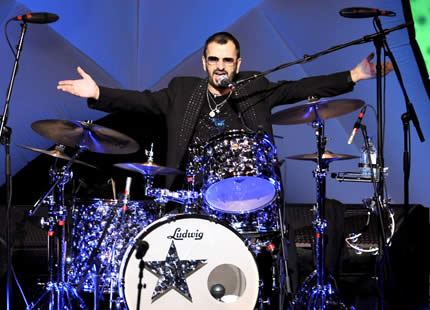
On 10 April 1970, McCartney publicly announced that he had quit the Beatles. Shortly before this, he and Starr fell out due to McCartney’s refusal to cede the release date of his eponymous solo album to allow for Starr’s debut, Sentimental Journey, and the Beatles’ Let It Be.
Starr’s album – composed of renditions of pre-rock standards that included musical arrangements by Quincy Jones, Maurice Gibb, George Martin and McCartney – peaked at number seven in the UK and number 22 in the US.
Starr followed Sentimental Journey with the country-inspired Beaucoups of Blues, engineered by Scotty Moore and featuring renowned Nashville session musician Pete Drake. Despite receiving some ffavorablereviews, the album failed to meet with commercial success. Starr subsequently combined his musical activities with developing a career as a film actor.
Starr played drums on Lennon’s John Lennon/Plastic Ono Band (1970), Ono’s Yoko Ono/Plastic Ono Band (1970), and on Harrison’s albums All Things Must Pass (1970), Living in the Material World (1973) and Dark Horse (1974). In 1971, Starr participated in the Concert for Bangladesh, organised by Harrison, and with him co-wrote the hit single “It Don’t Come Easy”, which reached number four in both the US and the UK.
The following year he released his most successful UK hit, “Back Off Boogaloo” (again produced and co-written by Harrison), which peaked at number two (US number nine). Having become friends with the English singer Marc Bolan, Starr made his directorial debut with the 1972 T. Rex documentary Born to Boogie.
In 1973, Starr earned two number one hits in the US: “Photograph”, a UK number eight hit that he co-wrote with Harrison, and “You’re Sixteen”, written by the Sherman Brothers. Starr’s third million-selling single, “You’re Sixteen” was released in the UK in February 1974 where it peaked at number four in the charts.
Both songs appeared on Starr’s debut rock album, Ringo, which was produced by Richard Perry and featured writing and musical contributions from Lennon, McCartney and Harrison.
A commercial and critical success, the LP also included “Oh My My”, a US number five. The album reached number seven in the UK and number two in the US. Author Peter Doggett describes Ringo as a template for Starr’s solo career, saying that, as a musician first rather than a songwriter, “he would rely on his friends and his charm, and if both were on tap, then the results were usually appealing.”
Goodnight Vienna followed in 1974 and was also successful, reaching number eight in the US and number 30 in the UK. Featuring musical contributions from Lennon, Elton John and Harry Nilsson, the album included a cover of the Platters’ “Only You (And You Alone)”, which peaked at number six in the US and number 28 in the UK, and Hoyt Axton’s “No No Song”, which was a US number three and Starr’s seventh consecutive top-ten hit. The John-written “Snookeroo” failed to chart in the UK, however, when issued there as the second single from the album. During this period Starr became romantically involved with Lynsey de Paul.
He played tambourine on a song she wrote and produced for Vera Lynn, “Don’t You Remember When”, and he inspired another De Paul song, “If I Don’t Get You the Next One Will”, which she described as being about revenge after he missed a dinner appointment with her because he was asleep in his office.
Starr founded the record label Ring O’Records in 1975. The company signed eleven artists and released fifteen singles and five albums between 1975 and 1978, including works by David Hentschel, Graham Bonnet and Rab Noakes. The commercial impact of Starr’s own career diminished over the same period, however, although he continued to record and remained a familiar celebrity presence. Speaking in 2001, he attributed this downward turn to his “[not] taking enough interest” in music, saying of himself and friends such as Nilsson and Keith Moon: “We weren’t musicians dabbling in drugs and alcohol; now we were junkies dabbling in music.” Starr and Moon were members of a drinking club, The Hollywood Vampires.
In November 1976 Starr appeared as a guest at the Band’s farewell concert, featured in the 1978 Martin Scorsese documentary The Last Waltz. Also in 1976, Starr issued Ringo’s Rotogravure, the first release under his new contract with Atlantic Records for the North American market and Polydor for all other territories. The album was produced by Arif Mardin and featured compositions by Lennon, McCartney and Harrison.
Starr promoted the release heavily, yet Rotogravure and its accompanying singles failed to chart in the UK. In America, the LP produced two minor hits, “A Dose of Rock ‘n’ Roll” (number 26) and a cover of “Hey! Baby” (number 74), and achieved moderate sales, reaching a chart position of 28.
Its disappointing performance inspired Atlantic to revamp Starr’s formula; the result was a curious blend of disco and 1970s pop, titled Ringo the 4th (1977). The album was a commercial disaster, failing to chart in the UK and peaking at number 162 in the US.
The album was produced by Arif Mardin and featured compositions by Lennon, McCartney and Harrison. Starr promoted the release heavily, yet Rotogravure and its accompanying singles failed to chart in the UK. In America, the LP produced two minor hits, “A Dose of Rock ‘n’ Roll” (number 26) and a cover of “Hey! Baby” (number 74), and achieved moderate sales, reaching a chart position of 28.
In 1978 Starr released Bad Boy, which reached a disappointing number 129 in the US and again failed to place on the UK albums chart.
1980s
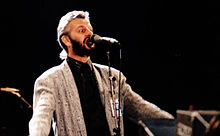 Following Lennon’s murder in December 1980, Harrison modified the lyrics of a song he had originally written for Starr, “All Those Years Ago”, as a tribute to their former bandmate. Released as a Harrison single in 1981, the track, which included Starr’s drum part and overdubbed backing vocals by Paul and Linda McCartney, peaked at number two in the US charts and number 13 in the UK.Later that year, Starr released Stop and Smell the Roses, featuring songs produced by Nilsson, McCartney, Harrison, Ronnie Wood and Stephen Stills
Following Lennon’s murder in December 1980, Harrison modified the lyrics of a song he had originally written for Starr, “All Those Years Ago”, as a tribute to their former bandmate. Released as a Harrison single in 1981, the track, which included Starr’s drum part and overdubbed backing vocals by Paul and Linda McCartney, peaked at number two in the US charts and number 13 in the UK.Later that year, Starr released Stop and Smell the Roses, featuring songs produced by Nilsson, McCartney, Harrison, Ronnie Wood and Stephen Stills
The album’s lead single, the Harrison-composed “Wrack My Brain”, reached number 38 in the US charts, but failed to chart in the UK.] Lennon had offered a pair of songs for inclusion on the album – “Nobody Told Me” and “Life Begins at 40” – but following his death, Starr did not feel comfortable recording them.
Soon after the murder, Starr and his girlfriend Barbara Bach flew to New York City to be with Lennon’s widow Yoko Ono.
Later that year, Starr released Stop and Smell the Roses, featuring songs produced by Nilsson, McCartney, Harrison, Ronnie Wood and Stephen Stills. The album’s lead single, the Harrison-composed “Wrack My Brain”, reached number 38 in the US charts, but failed to chart in the UK. Lennon had offered a pair of songs for inclusion on the album – “Nobody Told Me” and “Life Begins at 40” – but following his death, Starr did not feel comfortable recording them. Soon after the murder, Starr and his girlfriend Barbara Bach flew to New York City to be with Lennon’s widow Yoko Ono.
Lennon had offered a pair of songs for inclusion on the album – “Nobody Told Me” and “Life Begins at 40” – but following his death, Starr did not feel comfortable recording them. Soon after the murder, Starr and his girlfriend Barbara Bach flew to New York City to be with Lennon’s widow Yoko Ono.
Following Stop and Smell the Roses, Starr’s recording projects were beset with problems. After completing Old Wave in 1982 with producer Joe Walsh, he was unable to find a record company willing to release the album in the UK or the US. In 1987, he abandoned sessions in Memphis for a planned country album, produced by Chips Moman, after which Moman was blocked by a court injunction from issuing the recordings.
Starr nevertheless maintained a high public profile through his narration over 1984–86 of the popular children’s series Thomas & Friends, a Britt Allcroft production based on the books by the Reverend W. Awdry.
For a single season in 1989, Starr also portrayed the character Mr. Conductor in the program’s American spin-off, Shining Time Station.
In 1985, Starr performed with his son Zak as part of Artists United Against Apartheid on the recording “Sun City”, and, with Harrison and Eric Clapton, was among the special guests on Carl Perkins’ TV special Blue Suede Shoes: A Rockabilly Session.
In 1987, he played drums on Harrison’s Beatles pastiche “When We Was Fab” and also appeared in Godley & Creme’s innovative video clip for the song. The same year, Starr joined Harrison, Clapton, Jeff Lynne and Elton John in a performance at London’s Wembley Arena for the Prince’s Trust charity.
In January 1988, he attended the Rock and Roll Hall of Fame ceremony in New York, with Harrison and Ono (the latter representing Lennon), to accept the Beatles’ induction into the Hall of Fame.
During October and November 1988, Starr and Bach attended a detox clinic in Tucson, Arizona, each receiving a six-week treatment for alcoholism. He later commented on his longstanding addiction: “Years I’ve lost, absolute years … I’ve no idea what happened. I lived in a blackout.”
Having embraced sobriety, Starr focused on re-establishing his career by making a return to touring. On 23 July 1989, Ringo Starr & His All-Starr Band gave their first performance to an audience of ten thousand in Dallas, Texas. Setting a pattern that would continue over the following decades,] the band consisted of Starr and an assortment of musicians who had been successful in their own right with popular songs at different times.
The concerts interchanged Starr’s singing, including selections of his Beatles and solo songs, with performances of each of the other artists’ well-known material, the latter incorporating either Starr or another musician as drummer. The first All-Starr excursion led to the release of Ringo Starr and His All-Starr Band (1990), a compilation of live performances from the 1989 tour.
Also in 1990, Starr recorded a version of the song “I Call Your Name” for a television special marking the 10th anniversary of John Lennon’s death and the 50th anniversary of Lennon’s birth. The track, produced by Lynne, features a supergroup composed of Lynne, Tom Petty, Joe Walsh and Jim Keltner.
The following year, Starr made a cameo appearance on The Simpsons episode “Brush with Greatness” and contributed an original song, “You Never Know”, to the soundtrack of the John Hughes film Curly Sue.
In 1992, Starr released his first studio album in nine years, Time Takes Time, which was produced by Phil Ramone, Don Was, Lynne and Peter Asher and featured guest appearances by various stars including Brian Wilson and Harry Nilsson. The album failed to achieve commercial success, although the single “Weight of the World” peaked at number 74 in the UK, marking Starr’s first appearance on the singles chart there since “Only You” in 1974.
In 1994, Starr began a collaboration with the surviving former Beatles for the Beatles Anthology project. They recorded two new Beatles songs built around solo vocal and piano tapes recorded by Lennon and gave lengthy interviews about the Beatles’ career. Released in December 1995, “Free as a Bird” was the first new Beatles single since 1970.
In March 1996, they released a second single, “Real Love”. The temporary reunion ended when Harrison refused to participate in the completion of a third song. Starr then played drums on McCartney’s 1997 album Flaming Pie. Among the tracks to which he contributed, “Little Willow” was a song McCartney wrote about Starr’s ex-wife Maureen, who died in 1994, while “Really Love You” was the first official release ever credited to McCartney–Starkey.
In 1998, Starr released two albums on the Mercury label. The studio album Vertical Man marked the beginning of a nine-year partnership with Mark Hudson, who produced the album and, with his band the Roundheads, formed the core of the backing group on the recordings. In addition, many famous guests joined on various tracks, including Martin, Petty, McCartney and, in his final appearance on a Starr album, Harrison. Most of the songs were written by Starr and the band. Joe Walsh and the Roundheads joined Starr for his appearance on VH1 Storytellers, which was released as an album under the same name. During the show, he performed greatest hits and new songs and told anecdotes relating to them.
Starr’s final release for Mercury was the 1999 Christmas-themed I Wanna Be Santa Claus. The album was a commercial failure, although the record company chose not to issue it in Britain.
2000s
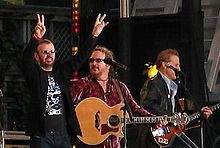 Starr was inducted into the Percussive Arts Society Hall of Fame in 2002, joining an elite group including Buddy Rich, William F. Ludwig, Sr., and William F. Ludwig, Jr.
Starr was inducted into the Percussive Arts Society Hall of Fame in 2002, joining an elite group including Buddy Rich, William F. Ludwig, Sr., and William F. Ludwig, Jr.
On 29 November 2002 (the first anniversary of Harrison’s death), he performed “Photograph” and a cover of Carl Perkins’ “Honey Don’t” at the Concert for George held in the Royal Albert Hall, London.
Early the following year, Starr released the album Ringo Rama, which contained a song he co-wrote as a tribute to Harrison, “Never Without You”.
Also in 2003, Starr formed Pumkinhead Records with All-Starr Band member Mark Hudson. The label was not prolific, but their first signing was Liam Lynch, who produced a 2003 LP entitled Fake Songs.
![]() Starr served as an honorary Santa Tracker and voice-over personality in 2003 and 2004 during the London stop in Father Christmas’s annual Christmas Eve journey, as depicted in the annual NORAD tracks Santa program. According to NORAD officials, he was “a Starr in the east” who helped guide North American Aerospace Defense Command’s Santa-tracking tradition.
Starr served as an honorary Santa Tracker and voice-over personality in 2003 and 2004 during the London stop in Father Christmas’s annual Christmas Eve journey, as depicted in the annual NORAD tracks Santa program. According to NORAD officials, he was “a Starr in the east” who helped guide North American Aerospace Defense Command’s Santa-tracking tradition.
Starr’s 2005 release Choose Love eschewed the star-guests approach of his last two studio albums but failed to chart in the UK or the US.
That same year, Liverpool’s City Council announced plans to demolish Starr’s birthplace, 9 Madryn Street, stating that it had “no historical significance”. The LCC later announced that the building would be taken apart brick by brick and preserved.
Starr released the album Liverpool 8 in January 2008, coinciding with the start of Liverpool’s year as the European Capital of Culture.
Hudson was the initial producer of the recordings, but after a falling out with Starr, he was replaced by David A. Stewart. Starr performed the title track at the opening ceremony for Liverpool’s appointment, but thereafter attracted controversy over his seemingly unflattering comments about his city of birth.
Later that year, he was the object of further criticism in the press for posting a video on his website in which he harangued fans and autograph hunters for sending him items to sign.
In April 2009, Starr reunited with McCartney at the David Lynch Foundation’s “Change Begins Within” benefit concert, held at New York’s Radio City Music Hall. Having played his own set beforehand, Starr joined McCartney for the finale and performed “With a Little Help from My Friends”, among other songs.
Starr also appeared on-stage during Microsoft’s June 2009 E3 press conference with Yoko Ono, McCartney and Olivia Harrison to promote The Beatles: Rock Band video game. In November 2009, Starr once again performed the voice of Thomas the Tank Engine for “The Official BBC Children in Need Medley”.
